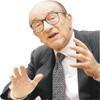
refid:11067694 ilişkili resim dosyası
The premium banks charge each other for short-term loans, the so-called Libor-OIS spread, rose above 1 percentage point last week for the first time since Jan. 9. Contracts traded in the forward market indicate the gauge, which measures banks reluctance to lend, will remain higher for the rest of the year than before Sept. 15, when the bankruptcy of Lehman Brothers Holdings Inc. froze credit markets.
"Libor-OIS remains a barometer of fears of bank insolvency," former Federal Reserve Chairman Alan Greenspan said in an interview. "That fear has been substantially reduced since mid-October, but the decline has stalled well short of any semblance of normal markets."
The lack of lending between banks helped send the U.S. economy into a recession and may delay recovery. Turmoil in money markets stoked last year’s tumble in stocks and fueled demand for the relative safety of Treasuries, gold and Japanese yen. Since Lehman collapsed, the Standard & Poor’s 500 Index lost 35 percent, 10-year Treasury yields fell below 3 percent, gold topped $1,000 an ounce and the yen climbed 12 percent.
"The fundamental outlook hasn’t changed," said Jay Mueller, who manages about $3 billion of bonds at Wells Fargo Capital Management in Milwaukee.After taking about $1.1 trillion of writedowns and losses since the start of 2007, the financial system remains so troubled that the government may have to nationalize some banks for a short time, Senate Banking Committee Chairman Christopher Dodd said.
"I don’t welcome that at all, but I could see how it’s possible it may happen," Dodd, a Connecticut Democrat, said in a Feb. 20 interview on Bloomberg Television’s "Political Capital with Al Hunt."Citigroup Inc., the recipient of $45 billion in U.S. government aid, is in talks with federal officials that may increase state ownership of the bank, the Wall Street Journal said today, citing people it didn’t identify.
The stress is all reflected in the Libor-OIS spread, which measures the gap between the London interbank offered rate in dollars for three months and the overnight index-swap rate, or what traders expect the Fed’s target rate for overnight loans between banks to average over the term of the contract.
That spread averaged 0.11 percentage point between December 2001 and July 2007, before shooting to 0.73 percentage point the next month as losses from investments tied to subprime mortgages accelerated.
The Lehman effect
After Lehman filed for bankruptcy, the measure soared to 3.64 percentage points from about 0.87 percentage point as interbank lending seized up on concern more firms would collapse. While the spread has narrowed, Greenspan, the chairman of the Fed from August 1987 to January 2006, said in June he won’t consider markets back to ’normal’ until Libor-OIS falls to 0.25 percentage point.
Contracts traded in the forwards market show traders expect the spread to narrow to 0.83 percentage point by December, according to data compiled by Tullett Prebon, the second-biggest broker of transactions between banks. "We are nowhere near the levels that you’d want to see to indicate a well functioning banking system," said Jeffrey Caughron, chief market analyst in Oklahoma City at Baker Group, which advises community banks investing $20 billion of assets. "People still don’t get it in terms of how bad things are in the domestic and global economies."U.S. financial losses may reach $3.6 trillion, suggesting the banking system is ’insolvent,’ Professor Nouriel Roubini, who predicted the economy was headed for a ’hard landing,’ said on Jan. 20.